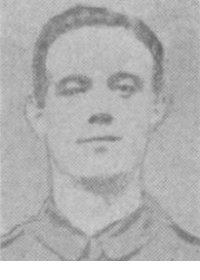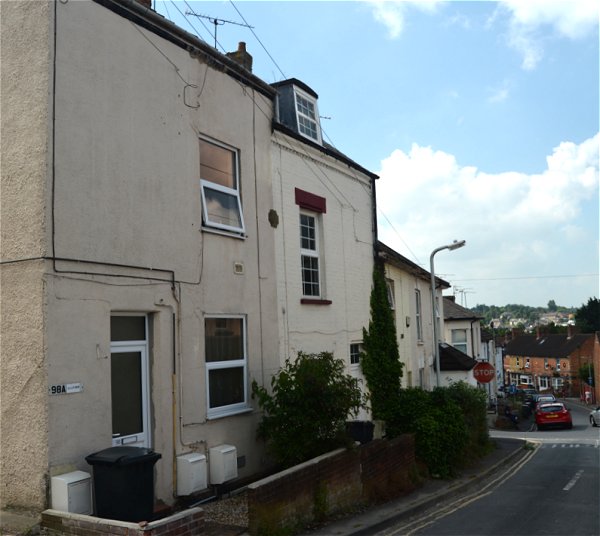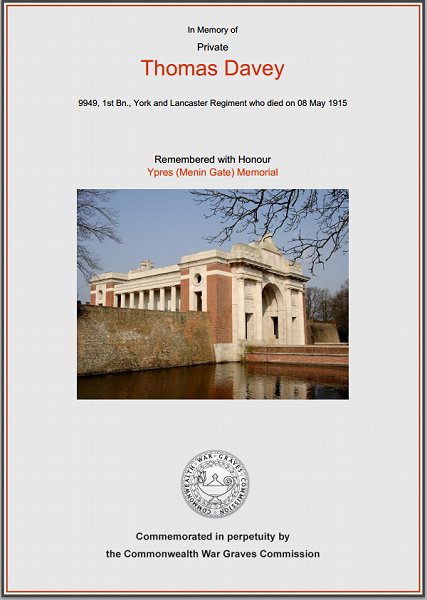yeovil at War
Charles Thomas Davey
Wounded and missing in action, presumed killed
 Charles
Thomas Davey was
born in
Newtown,
Yeovil, during
the summer of
1893. He was the
son of railway
engine driver
John Davey
(1857-1923),
originally from
Wear Gifford,
Devon and Mary née Hockridge (b
1857).
Charles
Thomas Davey was
born in
Newtown,
Yeovil, during
the summer of
1893. He was the
son of railway
engine driver
John Davey
(1857-1923),
originally from
Wear Gifford,
Devon and Mary née Hockridge (b
1857).
In the 1901 census John and Mary were listed living at 4 Agra Place, Eastland Road, Newtown, Yeovil, with their children; William Percy (b 1883), Thirza Ann (1886-1918), Lillian (b 1889), Frederick John (1890-1972), Sidney George (1891-1971), 7-year old Charles and Elsie May (b 1895). In total John and Mary had eleven children, only nine of whom survived childhood.
By the time of the 1911 census John had retired as an invalid and he and Mary were still living at Agra Place with some of their children. Charles, by this time known as Thomas, had left home (indeed the Thomas Charles / Charles Thomas appear interchangeable depending on the source consulted).
 In
fact 17-year old
Thomas was by
this time
serving in the
3rd Battalion,
Dorsetshire
Regiment and was
stationed at
Dorchester Depôt
Barracks. This
was a Special
Reserve
battalion
(formerly the
Dorset Militia).
The creation of
the Special
Reserve in
1907/8 from the
rump of the
Militia was
intended to
supply men as
drafts (not
fighting units)
when required,
these men
trained
initially for
about half a
year and then
released to
pursue civil
occupations.
In
fact 17-year old
Thomas was by
this time
serving in the
3rd Battalion,
Dorsetshire
Regiment and was
stationed at
Dorchester Depôt
Barracks. This
was a Special
Reserve
battalion
(formerly the
Dorset Militia).
The creation of
the Special
Reserve in
1907/8 from the
rump of the
Militia was
intended to
supply men as
drafts (not
fighting units)
when required,
these men
trained
initially for
about half a
year and then
released to
pursue civil
occupations.
Thomas re-enlisted at Sherborne as a regular soldier and joined the 1st Battalion, York and Lancaster Regiment. From his Service Number 9949, we know that he enlisted on 1 July 1911. The battalion had been in India since 1902 and remained there until the outbreak of the First World War in 1914, so consequently Thomas saw some three years service in India, stationed chiefly at Jubbulpore. On 4 August 1914 the Regiment left Jubbulpore and on 22 November sailed from Bombay for England, arriving at Southampton on 23 December 1914. It then formed within the new regular 28th Division for service in France and Belgium, landing at Le Havre on 17 January 1915.
The York and Lancaster Regiment raised 22 battalions for service in the Great War. During the war it suffered 48,650 casualties out of 57,000 men serving, with 8,814 killed or died of wounds (72 out of every 100 men being either wounded or killed). The regiment won four Victoria Crosses and 59 battle honours, the largest number for any English regiment during the war.
The first major conflict in which the York and Lancaster Regiment, including Thomas, took part was the Second Battle of Ypres.
The Second Battle of Ypres, 22 April-25 May 1915, was a rare German offensive on the Western Front during 1915. It was launched with two aims in mind. The first was to distract attention from the movement of German troops to the eastern front in preparation for the campaign that would lead to the victory of Gorlice-Tarnow. The second was to assess the impact of poisoned gas on the western front. Gas had already been used on the eastern front, at Bolimov (3 January 1915), but the tear gas used there had frozen in the extreme cold. At Ypres the Germans used the first lethal gas of the war, chlorine. The gas was to be released from 6,000 cylinders and would rely on the wind to blow it over the allied trenches. This method of delivery controlled the timing of the attack – the prevailing winds on the western front came from the west, so the Germans had to wait for a suitable wind from the east to launch their attack. The line around Ypres was held by French, Canadian and British troops. The attack on 22 April hit the French lines worst and, not surprisingly, the line broke under the impact of this deadly new weapon. The gas created a gap 8,000 yards long in the Allied lines north of Ypres. The success of their gas had surprised the Germans who didn’t have the reserves to quickly exploit the unexpected breakthrough, allowing enough time to plug the gap with newly arrived Canadian troops. During the battle the British, French and Canadians suffered 60,000 casualties, the Germans only 35,000.
On 8 May Thomas was shot in the leg and, it seems, may have been taken prisoner by the Germans. However it appears there was no further news of him and therefore he was officially listed as killed in action on that date. He was aged 21.
The Western Gazette, in its edition of 23 July 1915 reported "Private Thomas Charles Davey, of the 1st York and Lancashire Regiment, fourth son of Mr and Mrs John Davey, of 2 Ivy Cottages, Union Street, who on June 12th was recorded as being wounded has since been classified with the wounded and missing. No tidings have been received of him since he is believed to have been wounded. Some light seems to be thrown on the matter, however, by a letter written by Private H. Carter, of the same regiment to Private Davey’s eldest brother at Battersea in which he states:- “I have made enquiry about your brother, and from what his chum told me he was wounded in the attack we made on the night of May 8th just in front of the German trenches; I think in the right leg. In any case it was a leg hit. As we had to fall back on our own trenches there is not the least doubt he was taken prisoner the following morning.”
On 8 October 1915 the Western Gazette further reported "Mr J Davey, of 2 Ivy Cottages, Union Street, father of Private Thomas Charles Davey (1st York and Lancashire Regiment), who is wounded and missing, has received a report from the Red Cross Society, sent through the Germany Embassy in Berlin, to the effect that there is no information concerning his son at the present time."
Thomas Davey is commemorated on the Ypres (Menin Gate) Memorial, West-Vlaanderen, Belgium, and his name is recorded on the War Memorial in the Borough.
gallery

Agra Place, Eastland Road. Photographed in 2014.

The Commonwealth War Graves Commission certificate in memory of Thomas Davey.